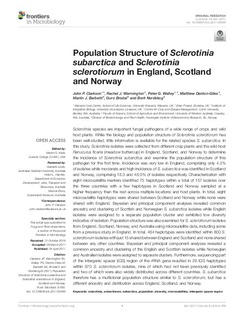| dc.contributor.author | Clarkson, John P. | |
| dc.contributor.author | Warmington, Rachel J. | |
| dc.contributor.author | Walley, Peter G. | |
| dc.contributor.author | Denton-Giles, Matthew | |
| dc.contributor.author | Barbetti, Martin J. | |
| dc.contributor.author | Brodal, Guro | |
| dc.contributor.author | Nordskog, Berit | |
| dc.date.accessioned | 2018-06-28T12:01:00Z | |
| dc.date.available | 2018-06-28T12:01:00Z | |
| dc.date.created | 2017-06-12T19:14:42Z | |
| dc.date.issued | 2017 | |
| dc.identifier.issn | 1664-302X | |
| dc.identifier.uri | http://hdl.handle.net/11250/2503606 | |
| dc.description.abstract | Sclerotinia species are important fungal pathogens of a wide range of crops and wild host plants. While the biology and population structure of Sclerotinia sclerotiorum has been well-studied, little information is available for the related species S. subarctica. In this study, Sclerotinia isolates were collected from different crop plants and the wild host Ranuculus ficaria (meadow buttercup) in England, Scotland, and Norway to determine the incidence of Sclerotinia subarctica and examine the population structure of this pathogen for the first time. Incidence was very low in England, comprising only 4.3% of isolates while moderate and high incidence of S. subarctica was identified in Scotland and Norway, comprising 18.3 and 48.0% of isolates respectively. Characterization with eight microsatellite markers identified 75 haplotypes within a total of 157 isolates over the three countries with a few haplotypes in Scotland and Norway sampled at a higher frequency than the rest across multiple locations and host plants. In total, eight microsatellite haplotypes were shared between Scotland and Norway while none were shared with England. Bayesian and principal component analyses revealed common ancestry and clustering of Scottish and Norwegian S. subarctica isolates while English isolates were assigned to a separate population cluster and exhibited low diversity indicative of isolation. Population structure was also examined for S. sclerotiorum isolates from England, Scotland, Norway, and Australia using microsatellite data, including some from a previous study in England. In total, 484 haplotypes were identified within 800 S. sclerotiorum isolates with just 15 shared between England and Scotland and none shared between any other countries. Bayesian and principal component analyses revealed a common ancestry and clustering of the English and Scottish isolates while Norwegian and Australian isolates were assigned to separate clusters. Furthermore, sequencing part of the intergenic spacer (IGS) region of the rRNA gene resulted in 26 IGS haplotypes within 870 S. sclerotiorum isolates, nine of which had not been previously identified and two of which were also widely distributed across different countries. S. subarctica therefore has a multiclonal population structure similar to S. sclerotiorum, but has a different ancestry and distribution across England, Scotland, and Norway. | nb_NO |
| dc.description.abstract | Population Structure of Sclerotinia subarctica and Sclerotinia sclerotiorum in England, Scotland and Norway | nb_NO |
| dc.language.iso | eng | nb_NO |
| dc.rights | Navngivelse 4.0 Internasjonal | * |
| dc.rights.uri | http://creativecommons.org/licenses/by/4.0/deed.no | * |
| dc.title | Population Structure of Sclerotinia subarctica and Sclerotinia sclerotiorum in England, Scotland and Norway | nb_NO |
| dc.title.alternative | Population Structure of Sclerotinia subarctica and Sclerotinia sclerotiorum in England, Scotland and Norway | nb_NO |
| dc.type | Journal article | nb_NO |
| dc.type | Peer reviewed | nb_NO |
| dc.description.version | publishedVersion | nb_NO |
| dc.rights.holder | Copyright © 2017 Clarkson, Warmington, Walley, Denton-Giles, Barbetti, Brodal and Nordskog | nb_NO |
| dc.subject.nsi | VDP::Matematikk og Naturvitenskap: 400 | nb_NO |
| dc.source.volume | 8 | nb_NO |
| dc.source.journal | Frontiers in Microbiology | nb_NO |
| dc.identifier.doi | 10.3389/fmicb.2017.00490 | |
| dc.identifier.cristin | 1475526 | |
| cristin.ispublished | true | |
| cristin.fulltext | original | |
| cristin.qualitycode | 1 | |

